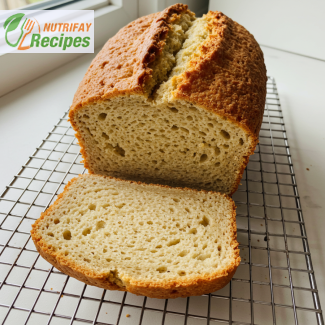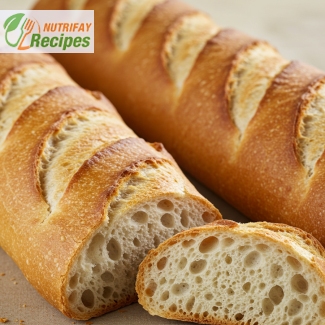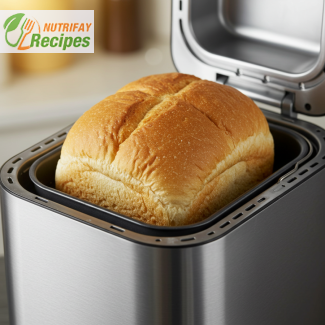Wholesome and Delicious Homemade Protein Bread
A Nutrient-Dense, High-Protein Loaf for Every Occasion
Finding a homemade bread that is both high in protein and full of delicious flavor can be a challenge. Many protein-rich breads on the market compromise on taste, leaving them dry, dense, or lacking the soft, airy texture we all crave. This high-protein bread recipe is the perfect solution—offering a well-balanced blend of nutrients, texture, and flavor while keeping it easy to prepare in your own kitchen. Whether you need a post-workout snack, a protein-rich breakfast, or a satisfying base for sandwiches, this recipe is designed to fuel your day the right way.
Made with a carefully selected combination of high-protein flours, Greek yogurt, eggs, and seeds, this bread provides a satisfying bite while maintaining a light and tender crumb. Unlike traditional bread, which is primarily carbohydrate-based, this recipe incorporates protein-rich ingredients that help with muscle recovery, sustained energy, and overall well-being.
Why This High-Protein Bread Stands Out
One of the most significant advantages of this homemade protein bread is its versatility. Whether you enjoy it fresh out of the oven, toasted with a spread of nut butter, or paired with savory toppings like smoked salmon and avocado, it remains delicious, wholesome, and nutrient-packed.
Unlike commercial protein breads, which often include artificial additives and preservatives, this version is completely homemade, natural, and free from unnecessary fillers. You have full control over the ingredients, texture, and level of protein, ensuring a balanced, nutritious loaf without compromising on flavor and quality.
Key Ingredients That Make the Difference
Protein-Packed Flours
This bread incorporates a combination of almond flour, oat flour, and whole wheat flour, providing a balance of plant-based protein, fiber, and heart-healthy nutrients. These flours not only add depth of flavor but also contribute to a more satisfying and nutritious bread.
Greek Yogurt for Extra Moisture
Greek yogurt is a key ingredient in this recipe, adding a boost of protein while ensuring the loaf stays moist and tender. It also provides a slight tanginess, balancing out the rich, nutty notes of the flours.
Seeds and Nuts for a Nutrient Boost
Chia seeds, flaxseeds, and sunflower seeds add a crunchy texture while enhancing the bread’s overall protein and fiber content. These superfoods contribute essential omega-3 fatty acids and minerals, making every slice even more nutrient-dense.
Eggs for Structure and Stability
Eggs play an essential role in this high-protein bread, helping to create a stable, well-risen loaf while contributing additional protein and healthy fats. Their emulsifying properties result in a soft, fluffy texture that holds together beautifully.
Ideal for Active Lifestyles and Balanced Nutrition
This homemade protein bread is perfect for those who lead an active lifestyle, are looking to increase their daily protein intake, or simply want to enjoy a more nutrient-dense alternative to traditional bread. The combination of slow-digesting carbohydrates, protein, and healthy fats makes it a well-rounded choice that keeps you full longer, supports muscle maintenance, and stabilizes energy levels.
Whether you're an athlete, fitness enthusiast, or just someone who enjoys delicious, wholesome bread, this recipe is a game-changer. It’s designed to fit into a variety of diets, making it suitable for those following high-protein, low-carb, or balanced meal plans.
How to Enjoy This Protein Bread
This versatile bread can be enjoyed in countless ways, making it a staple in any kitchen. Some of the best ways to serve it include:
- Toasted with nut butter and sliced banana for a protein-rich breakfast
- Topped with avocado and eggs for a well-balanced, satisfying meal
- Used for sandwiches with lean protein and fresh vegetables
- Paired with soups and salads as a hearty side
- Turned into French toast for a delicious high-protein treat
Freshly Baked, Better Than Store-Bought
There’s something truly special about baking your own bread at home. The aroma of freshly baked bread filling your kitchen, the satisfaction of slicing into a warm, golden loaf, and the confidence of knowing exactly what goes into your food all make this recipe worth the effort.
Unlike store-bought options, this high-protein bread doesn’t contain unnecessary preservatives, stabilizers, or excessive amounts of salt. Instead, it’s made with clean, wholesome ingredients that provide both nutrition and taste.
With just a few simple ingredients and a bit of patience, you’ll have a delicious, nutritious loaf that’s perfect for meal prep, healthy eating, and everyday indulgence.
- Preheat the oven to 180°C (350°F) and line a loaf pan with parchment paper.
- In a large mixing bowl, combine almond flour, oat flour, and whole wheat flour. Stir in baking powder and salt.
- In a separate bowl, whisk together eggs and Greek yogurt until smooth.
- Gradually add the wet ingredients to the dry ingredients, mixing continuously to form a thick batter.
- Stir in chia seeds, flaxseeds, and sunflower seeds for added texture and protein.
- Slowly pour in water while mixing, ensuring a well-incorporated dough.
- Transfer the batter into the prepared loaf pan, smoothing the top evenly.
- Bake for 40 minutes or until a toothpick inserted in the center comes out clean.
- Let the bread cool for at least 15 minutes before slicing.
Enhancing the Flavor and Texture of Homemade Protein Bread
The Key to a Softer and More Flavorful Loaf
A well-balanced high-protein bread should be both nutrient-dense and delicious, offering a pleasant texture while maintaining its health benefits. However, some homemade protein breads can turn out too dense, dry, or bland due to the high-protein content, which can affect the structure of the dough. With a few simple adjustments, you can transform a basic protein bread recipe into a soft, flavorful, and satisfying loaf.
One of the most effective ways to enhance the texture is by adjusting the balance of moisture-retaining ingredients. Adding a little more Greek yogurt, eggs, or an extra splash of water can prevent the bread from becoming too dense. Additionally, incorporating a small amount of olive oil or melted butter can improve tenderness, while also contributing to a more complex, rich flavor.
Choosing the Right Protein-Rich Flours
The type of flour used plays a crucial role in both taste and texture. Since this recipe already includes a blend of almond flour, oat flour, and whole wheat flour, slight modifications can make a noticeable difference.
- For a lighter texture: Replace a portion of whole wheat flour with spelt flour, which has a slightly sweeter, nuttier flavor and produces a more tender crumb.
- For a chewier consistency: Adding a small amount of vital wheat gluten (around 5–10 g per loaf) can help create a more structured dough, making the bread less crumbly.
- For a nutty, earthy taste: Substituting some oat flour with buckwheat flour enhances the depth of flavor while adding extra nutrients.
How to Make the Bread More Flavorful
Although protein bread is often made with simple, natural ingredients, small tweaks can bring out more depth of flavor.
- A touch of natural sweetness: Adding a teaspoon of honey or maple syrup will subtly enhance the taste without making the bread overly sweet. This also balances out the nuttiness of almond and oat flour.
- Using fermented dairy: Instead of regular Greek yogurt, try kefir or buttermilk. These ingredients add a pleasant tangy note and improve the softness of the bread.
- Incorporating herbs and spices: For a savory variation, mix in a small amount of rosemary, thyme, or garlic powder. This is especially great when using the bread for sandwiches or toast.
The Benefits of Making Protein Bread at Home
Many store-bought high-protein breads contain preservatives, artificial stabilizers, and excess sodium, which can diminish their nutritional value. When making it at home, you have full control over ingredient quality, freshness, and customization.
- No artificial additives: Unlike commercial alternatives, homemade bread is free from chemical stabilizers, keeping it as natural and wholesome as possible.
- Better nutrient retention: Freshly baked bread preserves more of its natural vitamins and minerals, ensuring better overall nutritional benefits.
- Customizable for dietary needs: Whether you need a lower-carb version, a gluten-free alternative, or a lactose-free recipe, making the bread at home allows for simple ingredient swaps.
Common Mistakes to Avoid
Even with a well-balanced protein bread recipe, there are a few common mistakes that can impact the final result.
- Using too much flour: High-protein flours absorb more moisture than traditional wheat flour. Adding too much can result in a dry, heavy loaf. It’s best to measure flours precisely and adjust the liquid content if necessary.
- Overmixing the dough: Unlike regular bread dough, high-protein bread does not require extensive kneading. Overmixing can lead to a dense, tough texture.
- Skipping resting time: Letting the batter sit for 5–10 minutes before baking allows the flours and seeds to fully absorb the liquid, preventing an overly wet or undercooked center.
Healthier Alternatives for a More Nutritious Loaf
For those looking to maximize health benefits, a few ingredient swaps can make the bread even more nutrient-dense.
- Replace whole wheat flour with teff flour: Teff is rich in iron, calcium, and fiber, making it a great alternative for enhanced nutrition.
- Use flax eggs instead of regular eggs: For a plant-based version, mix 1 tablespoon of ground flaxseeds with 3 tablespoons of water per egg replacement. This adds extra fiber and omega-3 fatty acids.
- Swap Greek yogurt for cottage cheese: This boosts protein content even further while giving the bread an ultra-soft consistency.
How Storage Affects the Texture and Freshness
Proper storage techniques can extend the shelf life of homemade protein bread while maintaining its flavor and texture.
- Best way to store: Wrap the bread in a clean kitchen towel and place it in an airtight container at room temperature for up to 3 days.
- For longer freshness: Store slices in the refrigerator for up to a week, ensuring they are properly sealed to prevent drying out.
- Freezing for convenience: Slice the bread before freezing, then wrap individual slices in parchment paper. This makes it easy to thaw only what you need.
Final Tips for the Perfect High-Protein Loaf
- Experiment with different seeds: Adding sesame seeds, hemp seeds, or pumpkin seeds can boost both flavor and nutrition.
- Use a baking stone or preheated pan: This helps create a better crust while ensuring even baking.
- Don’t cut the bread too soon: Allowing it to rest for at least 15 minutes before slicing prevents crumbling and ensures the best texture.
By carefully choosing ingredients, avoiding common mistakes, and experimenting with flavors, you can elevate a simple high-protein bread into an exceptional, homemade staple that is healthy, delicious, and versatile.
This recipe contains gluten, eggs, and dairy. Individuals with nut allergies should avoid almond flour or replace it with an alternative.
Substitution Tips:
- Replace almond flour with coconut flour for a nut-free option.
- Swap Greek yogurt with dairy-free yogurt for a lactose-free version.
- Use gluten-free flour blend instead of whole wheat flour for a gluten-free loaf.
- Vitamin B1 (Thiamine): Supports nerve function and energy metabolism.
- Magnesium: Essential for muscle function and heart health.
- Iron: Supports oxygen transport in the body.
- Zinc: Boosts immune function and wound healing.
- Flaxseeds & chia seeds: Rich in lignans that reduce inflammation.
- Oat flour: Contains avenanthramides, which help lower blood pressure.
- Sunflower seeds: Provide vitamin E, protecting cells from oxidative damage.







